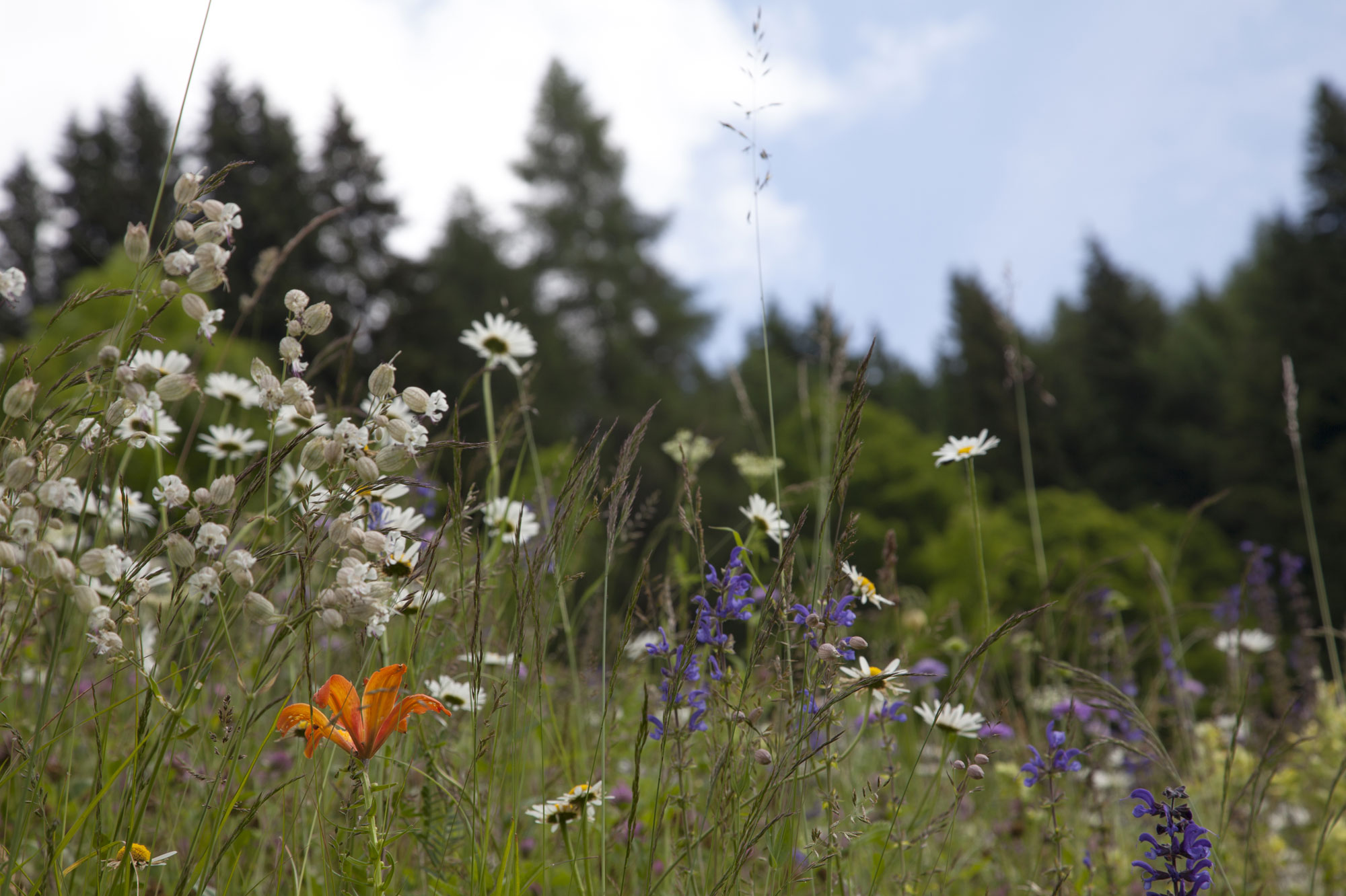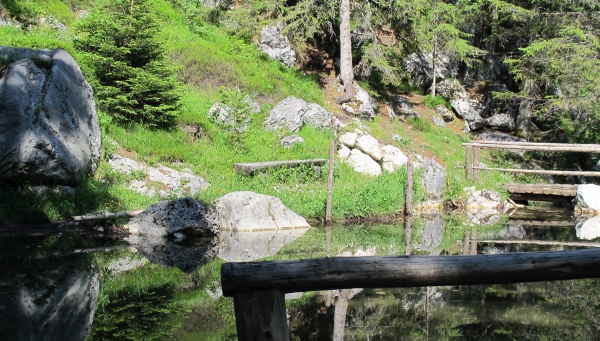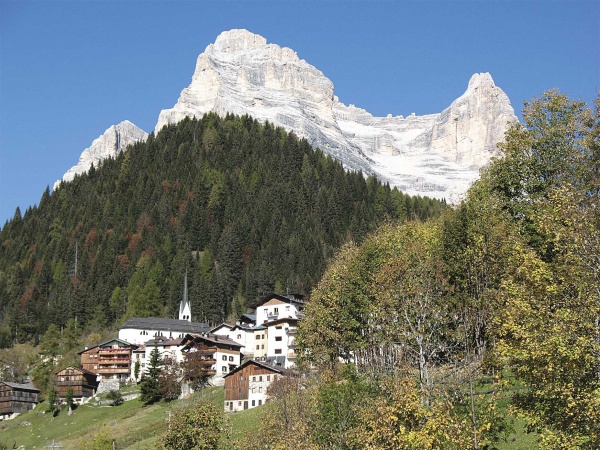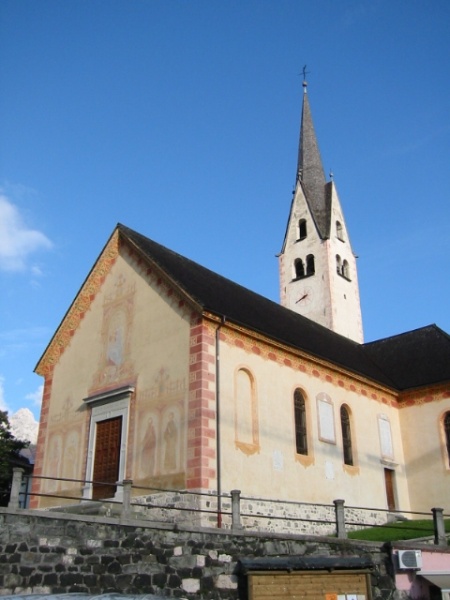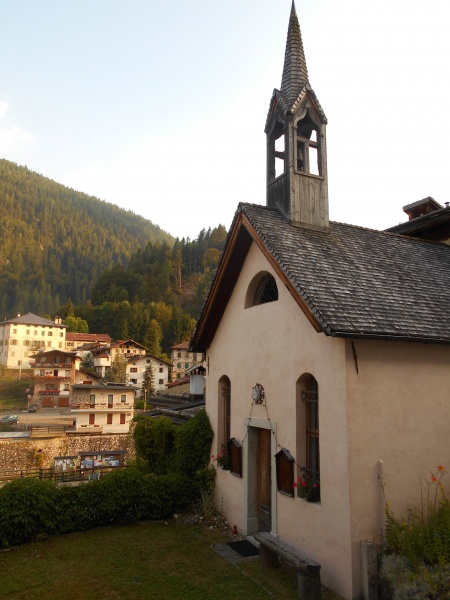Mount (Monte) Pelmo is an imposing massif that closes off the Val di Zoldo to the north, rising up between the Val Fiorentina and the Boite Valley. It is 3168 m high (recently remeasured as 3159 m) and is flanked to the west by a lower, yet no less imposing, mountain (Pelmetto, 2990 m), separated by the Fisura gorges.
Its peculiar appearance, formed by two monoliths, is the distinguishing feature of this mountain, known locally as “al caregon de’l Padreterno”, or “God’s throne”, because of the broad depression of the glacial cirque visible from the eastern side that makes it resemble a chair.
The only offshoots of the mountain are those of the Crode di Forca Rossa (2784 m) and the Cime di Val d’Arcia (2626 m), which descend towards the Boite Valley and the Cadore area.
Many are unaware that the Pelmo was the first peak of the Dolomites to be climbed: on 19 September 1857, the Englishman John Ball reached the summit along what would later become known as Ball ledge. He was accompanied by a local guide who did not make it to the top. Ball later wrote that he had chosen the Pelmo for his first ascent because he felt it was the most beautiful of all the mountains he had seen in the Dolomites.
The Pelmetto was climbed in 1896 by the mountain guides Clemente Callegari (known as Il Battistrada, the Pacemaker) and (nicknamed il Mago, the Magician).
Mountaineering access to the summit is possible from the Venezia Refuge, along the Bal ledge and the steep scree, following the challenging, thrilling normal route.
View from the summit
The summit offers views of most of the mountains in the Dolomites, with the most famous including the Antelao (3264 m), the Lastoi de Formin (2657 m), the Cernera Group (2657 m), the Tofane (3244 m), the Croda da Lago (2701 m), the Marmolada (3343 m) and the Civetta (3220 m), as well as the Sorapis (1085 m) and the Cristallo (3221 m). Also visible are the Cortina basin, the valleys of Zoldo and Selva di Cadore, and the Mondeval and Giau plateaus.
Walking routes and refuges
There are three refuges at the foot of the Pelmo: the Venezia-Alba Maria De Luca Refuge 1947 m to the east, the Città di Fiume Refuge 1918 m to the north-west and the Passo Staulanza Refuge 1766 m to the west.
The Città di Fiume Refuge, the only refuge in Italy to have been founded by a foreign Alpine Club (the Croatian Alpine Club), is popular with families, because it can be reached by walking along the convenient dirt road that starts out from the SP 251 provincial road. It is one of the stages on the Alta Via number 1, so it is also a destination for trekkers. From the refuge, it is also easy to reach the Mondeval plateau, a place of considerable scientific, historical and landscape interest; a delightful six-hour walk will also take visitors to the Giau Pass area, renowned for its beauty.
The Venezia Refuge, which can be reached both from the Val di Zoldo (along the panoramic path that starts out from the Passo Staulanza Pass, the more difficult Val d’Arcia path, or from Coi or Palafavera) and from the Cadore area (Zoppé and Borca), is a stop-off point both for walkers – including those tackling the Giro del Pelmo route – and for mountaineers seeking to reach the summit.
The Staulanza Refuge is a stop-off point for hikers to rest after walking along the numerous paths in the area, including those on the Alta Via no. 1, as well as for those simply passing through, since it is located on the Staulanza Pass, crossed by the SP 251 provincial road and thus easily accessible by car by visitors to the Dolomites.
In addition to the refuges, an unmissable attraction is the magnificent, sublime Mondeval plateau, with a surprising wealth of natural, historical and geological interest sure to awaken your imagination. Especially appealing is the little Baste Lake, with the surrounding peaks reflected in its waters, including the Pelmo and the "Città di pietra" (the city of stone), a group of erratic boulders resembling a lost stronghold.
The UNESCO Dolomites System 1
Mount Pelmo is part of System 1 “Pelmo Croda da Lago”, one of the serial sites in the Dolomites recognised by Unesco World Heritage as areas of inestimable, unique geological, landscape and natural importance. System 1 covers 4344 hectares, entirely within the Province of Belluno, and includes the following peaks: Monte Pelmo (3168 m), Pelmetto (2990 m), Croda da Lago (2701 m), Monte Formin (also known as Lastoi de Formin) (2657 m), Monte Cernera (2657 m), Becco di Mezzodì (2603 m), Monte Verdal (2491 m), la Rocchetta (2469 m), Corvo Alto (2455 m) and Col Piombin (2313 m).
Of particular interest are the findings in this area, such as those in the Mondeval de Sora site, discovered by Vittorino Cazzetta, including the remains of Valmo, a nomadic hunter who lived during the Mesolithic, also known as “Mondeval Man”. This was a discovery of unrivalled importance: the Mondeval site is the oldest in the world at such an altitude. Also of essential significance for archaeologists are the funerary accoutrements found, which have allowed academics to understand a great deal about how this man from 8000 years ago lived.
Mount Pelmetto offers a journey back even further in time: at the foot of the mountain, at an altitude of 2050 m, not far from the Staulanza Refuge, a rock has been found with dinosaur tracks dating to the Late Triassic, the first to be discovered in Italy. Five tracks have been identified, from three different types of animals: the clearest traces are of ornithischians, which were herbivores, while the others are of coleurosaurs, small carnivorous reptiles, and prosauropods, ancestors of the gigantic brontosauruses. The rock can be reached, by moving with great care (especially on the final stretch), starting out from the Staulanza Pass.
To find out more about these discoveries, a visit is recommended to the Vittorino Cazzetta Museum in Selva di Cadore.
Other traces of the presence of dinosaurs in the Monte Pelmo area have been found on the crest of the north-eastern face, at an altitude of almost 3000 metres.
The Pelmo in winter
The Pelmo and the surrounding area are excellent both for superb snowshoeing trips through unspoilt nature (such as the route that climbs up from the village of Coi to “I Lach”) and - when the snow conditions are ideal - for ski mountaineering (for example, the Forca Rossa and Col de la Puina itineraries). Discover some of the routes in the dedicated section of our website!
Thanks to the Val di Zoldo section of the Italian Alpine Club for their invaluable collaboration in preparing the material.









